Peneda-Gerês National Park
The Peneda-Gerês National Park (Portuguese: Parque Nacional da Peneda-Gerês), also known simply as Gerês, is the only national park in Portugal and is located in the Viana do Castelo, Braga, and Vila Real Districts. It was created on 8 May 1971 due to its national and international scientific interest, with the aim to protect the soil, water, flora, fauna, and landscape, while preserving its value to the existent human and natural resources. Education and tourism are also goals of the park.
| Peneda-Gerês National Park | |
|---|---|
IUCN category II (national park) | |
_(2).jpg) A view of the yellowish landscape of the Serra Amarela (Yellow Serra) | |
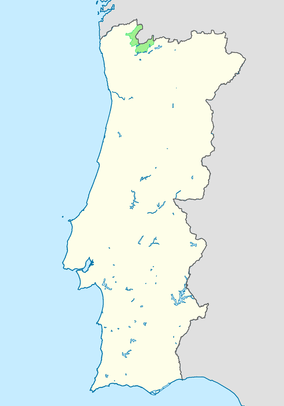 Location of the Peneda-Gerês National Park within continental Portugal | |
| Location | Norte, Portugal |
| Coordinates | 41°43′49.22″N 8°9′42.05″W |
| Length | 45.44 km (28.24 mi) |
| Width | 45.34 km (28.17 mi) |
| Area | 702.90 km2 (271.39 sq mi) |
| Elevation | 381 m (1,250 ft) |
| Established | May 1971 |
| Named for | the two extreme serras where the national park extends between Serra da Peneda and Serra do Gerês |
| Operator | Parque National da Peneda-Gerês Headquarters |
| Website | Parque Natural da Peneda-Gerês |
History
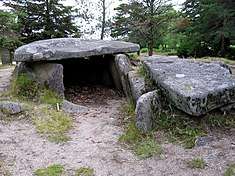
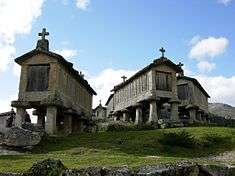
Probably, because the Gerês mountains are an inhospitable place, the oldest signs of human presence date only from 6000 BC to 3000 BC; dolmens and other megalithic tombs remain interspersed within the region, including near Castro Laboreiro and Mourela.[1] Human activities consisted of animal husbandry and incipient agriculture, and archaeological evidence points to the beginning of decrease in forest cover.[1]
The Roman Geira, a Roman road, crosses the region, which formerly connected the Roman civitates of Asturica Augusta and Braccara Augusta. Long stretches of the road, along the Homem River are still preserved, along with several Roman bridges and numerous millenarium markers. The Germanic tribe of the Buri accompanied the Suebi in their invasion of the Iberian Peninsula and establishment in Gallaecia (modern northern Portugal and Galicia). The Buri settled in the region between the Cávado and Homem Rivers, in the area later known as Terras de Bouro (Land of the Buri). The move from the terraced cliffs and slopes to the lowland river valleys brought-on a patterned of new deforestation.[1]
The reoccupation of mountain areas started in the 12th century, intensifying in the 16th century with the introduction of maize, beans, and potatoes from the Americas.[2] Agricultural fields occupied former pastures, and these were displaced to more elevated areas resulting in a mosaic of fields, pastures, and forests.[2]
The reforestation of uncultivated lands, imposed by the government in 1935, reduced the available pastures, and contributed to a rural exodus that continued after the 1950s.[2] Yet it was still common practice for the residents of mountain communities to spend part of the year in two locations, primarily near Castro Laboreiro. From about Easter to about Christmas, residents would live in homes over 1,000 m above sea level, known as branda (from the Portuguese brando, meaning ‘mild’ or ‘gentle’). In the remaining part of the year, these inhabitants would occupy homes in the river valley, known as inverneira (from the Portuguese inverno, meaning ‘winter’).
In 1970, the village of Vilarinho das Furnas was flooded by the Vilarinho das Furnas dam on the Homem River. During years with low rainfall, the village ruins stands above the water, attracting thousands of tourists.
The creation of the national park (completed under decree no. 187/71, 8 May 1971) envisioned a planning area of mountainous spaces, in order to conserve the environment, while permitting human and natural resource activities, which would include educational, touristic and scientific projects. At heart is the conservation of soils, water, flora and fauna, in addition to the preservation of landscapes within the vast mountainous region in the northwest of Portugal.
In 1997, Peneda-Gerês was included in the Natura 2000 network, and in 1999, designated a Special Protection Area for Wild Birds.[3] Moreover, it also encompasses an important area of natural forest, which forms part of the European Network of Biogenetic Reserves, and is recognized as a national park by the International Union for Conservation of Nature.[3] In 2007, it was accepted in the PAN Parks network that certifies the quality protected areas, according to rigorous criteria of nature conservation, cultural services and sustainability.[3]
Geography
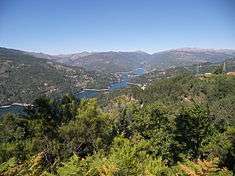
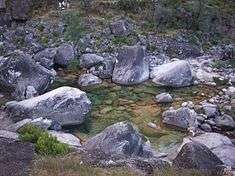
The Peneda-Gerês National Park is located in the northwest of Portugal, extending through the municipalities of Melgaço, Arcos de Valdevez and Ponte da Barca (in the district of Viana do Castelo), Terras de Bouro (district of Braga), and Montalegre (district of Vila Real). The park includes an area of 702.90 km2, of which 52.75 km2 are public lands, 194.38 km2 are private property and the remaining 455.77 km2 are commons.
Physical geography
The park is a vast amphitheatre-shaped space sculpted during the Variscan orogeny by geological forces, wind and water, and extends from the Castro Laboreiro to the Mourela plateaus, encompassing the Serra da Peneda, Serra do Soajo, Serra Amarela and the Serra do Gerês.[4][5] These form a barrier between the ocean plains to its west and the plateaus in the east. The highest peaks are Peneda (1340 m), Soajo (1430 m), Amarelo (1350 m), Gerês (1545 m) and Altar dos Cabrões (1,538 m) located on the border with Galicia, continuing into this territory as part of the Serra do Xurés.[5][6]
The granitic rocks that dominate this shield were deposited during the process of continental collision that brought together the lower Iberian peninsula with Europe, between 380 million and 275 million years;[4][6] the oldest of them, at Amarela, date from 310 million years ago. The most extensive of the granitic rocks that occur within the park are the Peneda-Gerês pluton which is an exposed relief that became exposed around 290-296 Ma by the Gerês-Lovios fault.[4] Sedimentary layers laid down between 435 and 408 Ma (Silurian epoch) were deformed and metamorphosed into schists, greywackes and quartzites (such as in the area of Castro Laboreiro).[4] Also, dykes and sills formed from quartz and aplite-pegmatites were mineralized resulting in tin, tungsten, molybdenum and gold (which would become the focus of mining in the human era, at the now-closed mines of Carris and Borrageiro).[4][6] Generally, the lithological structures can be divided into three layers:[7]
- Gerês granite structures - includes Gerês, Paufito, Carris, Borrageiro and Tieiras, and is composed of special mineralogical and geochemical intrusions that occurred through third phase of Hercynian faults, caused by a differentiating of basic magmas. The terrain in these regions include a vigorous relief, a rounded granite petrography, such as in the Serra da Peneda;[7]
- older granite structures - includes a very heterogeneous group of Mezio, Soajo, Serra Amarela, Linhoso, Parada, Tourém, Pedrada e Ermida, Germil, Sezelhe and Frades, with a texture and composition that quite variable, from the crustal fusion of various materials with surface contamination;[7]
- sedimentary formations - includes sediments deposited in Silurian waters and metamorphosed during the Devonian period, as well as carbon and more recent sediments, resulting during the Quaternary. The first group includes principally schists and quartz-feldspar, greywackes and quartzites with meta-crystals, such as andalusite, cordierite and sillimanite.[7] These sedminentary deposits are prominently preserved in two linear patches: Vale das Antas and Louriça, near Castro Laboreiro, between two granite structures. The most recent geological formations are those created by fluvial, torrential and glacial deposits.[6][7]
During the Pleistocene (approximately 1.8 to 0.001 Ma ago) climatic variations resulted in an extension of glacial fields to the mid-latitudes.[4] While there are no remnants of glaciers now, their Ice Age products (U-shaped valleys, moraines, glacial deposits, polished and natural granite surfaces) are identified in the Serra da Peneda, Serra do Soajo and Serra do Gerês mountain ranges.[4][7] The principal watersheds that cross the park are those of the Minho (occupying 2% of the park), Lima (47.8%) and Cávado (50.2%), with brooks and waterfalls common on many of the mountain slopes, in addition to several secondary tributaries (such as the Homem, Rabagão, Castro Laboreiro, and Arado rivers).[5][6] The Cávado cuts across the PNPG east to west, while the Lima serves the southern limits of the districts of Vila Real and Braga. Fractures in the landscape have confined the rivers to deep, straight valleys and are visible in the younger granite outcrops visible in the uncovered higher altitudes.[4] Owing to the number tributaries, the construction of hydroelectrical dams has been undertaken to generate electricity across six locations: Alto Rabagão, Paradela, Caniçada, Vilarinho da Furna, Touvedo and Lindoso.
Soils within the elevated terrains and inclined spaces are non-existent, while the valleys are rich and deep, deposited and transported by pluvial action.[8] These strata are textured, permeable, easily worked, albeit with a weak consistency, and marked by the peculiarities of local agriculture.[8][9] The incorporation of biomass and elevated precipitation, along with the low autumn-winter temperatures give an origin to the alterations in pH levels.[8] The elevated levels of incompletely decomposed organic material, low in phosphorus and intermittently low/high in potassium, are subject of alluvial deposition.[8]
Climate
The region of the Parque Nacional Peneda Geres falls within a transitional zone between the Atlantic and Mediterranean environments, and is influenced by various climatic systems: Atlantic, Mediterranean and Continental.[8] Its climate is greatly influenced by the topography; the mountains exert a barrier effect to the passage of hot and wet air masses coming from the Atlantic Ocean, resulting in elevated precipitation throughout the year.[10]
It falls in a part of Portugal (and Europe) that is affected by extreme rainfall, obtaining precipitation levels of 3000 millimetres per year,[8] with more than 130 rainy days per year. Average annual temperatures range from 17°C to 20°C, with some variation;[8] the high lands have an average temperature of about 10°C, ranging from 4 to 14 °C, while areas in the valleys (such as the Homem and Cávado river valleys) have milder climates, with temperatures ranging from 8 to 20 °C (with an average of 14 °C).
Consequently, the area is prone to various micro-climates, affected by variations in altitude, topographic characteristics, human occupation, different exposures and thermal variation.[8] Similarly, the variation has resulted in a variation in vegetation characteristic of Mediterranean, Euro-Siberian and Alpine environments.[8]
Biome
Rivas-Martinez defined that the foothills of the Serra da Gerês along with the foothills of the Serra da Cabreira (lands below the Tâmega, Ave and Cávado watersheds) constitute the frontier between the Euro-Siberian and Mediterranean regions, that confers on the Peneda-Gerês a floral and phytogeographic importance.[10][11]
Flora
Biomass coverage of the Serra do Gerês, Serra Amarela, Serra do Peneda and Serra do Soajo, as well as the Mourela and Castro Laboreiro plateaus, are dominated by four distinct biomes: oak forest, shrubbery, marshes and riparian vegetation.[11]
The floristic diversity includes 823 vascular taxa that occur in 128 types of natural vegetation.[10] The oak forests which are common throughout the park, are specifically concentrated in Ramiscal, Peneda, Gerês and Beredo river valleys. These forested are dominated by an alliance between the Pyrenean (Quercus pyrenaica) and English (Quercus robur) oaks, which themselves are differentiated among the lower altitudes and exposed flanks (the Rusceto-Quercetum roboris) and those oaks with Atlantic characteristics (Myretillo-Quercetum roboris).[11] The first association are commonly found with English oak (Quercus rober), cork oak (Quercus suber), butcher's broom (Ruscus aculeatus), maple (Acer pseudoplatanus) and Portuguese laurel (Prunus lusitanica), while the second association unites the English and Pyrenean oaks with bilberry (Vaccinium myrtillus), strawberry tree (Arbutus unedo) and European holly (Ilex aquifolium).[11] In upper altitudes there are patches of English oak that enter into their own association (Holco-Quercetum pyrenacia), which is integrated into another group (Quericon robri-patraea).[11][11] These oaks have been, over the course of human settlement, the object of intense use, resulting in a general degradation of the spaces into nothing more than shrubbery.
The bush and shrublands, which characterize the remainder of the spaces (74% of the park),[1] are dominated by dwarf (Ulex minor) and European (Ulex europaeus) gorse and heather (Erica umbellata and Calluna vulgaris), with a mixtures of common juniper (Juniperus communis), southern heather (Erica australis) in the upper altitudes, while lower altitude bush includes cross-leaved heather (Erica tetralix), dwarf gorse (Ulex minor), Dorset heath (Erica ciliaris), common sundew (Drosera rotundifolia), pale butterwort (Pinguicula lusitanica), marsh violet (Viola palustris) and purple moor grass (Molinia caerulea).[11]
Riparian and marshlands along the river courses are also sites of rare species of chain ferns (Woodwardia radicans), willow (Salix repens), downy birch (Betula pubescens), deciduous shrubs (Spiraea hypericifolia), Portuguese enchanter's nightshade (Circaea lusitanica) and angelica herbs (Angelica laevis).[12]
There are 627 flora species identified by Serra and Carvalho (1989) as under pressure and considered endangered, which included two medicinal plants: tutsan (Hypericum androsaemum) and sundew (Drosera rotundifolia).[12] Based on the protection list of botanical species, and UICN categories: 18 are considered in risk of extinction, 17 are vulnerable and one is rare. They also identified two species as extinct within the park boundaries: a geranium (Geranium lanuginosum) and fragrant orchid (Gymnadenia conopsea).[12] There are three endemic species. Those factors that have been identified that threaten these habitats include: natural and manmade fires, use of forest for fuel wood and agricultural use of habitats.[12]
Fauna
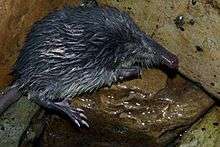
Many of the studies conducted on the species that inhabitant the park have been concentrated in the area of Matas de Albergaria/Palheiros, traditionally identified as the "heart" of the park.[13] Work by the Faculty of Sciences at the University of Porto and University of Minho have concentrated on a few mammals (Pyrenean desman, European otter, roe deer, and wild boar), reptiles and fish.[13] These studies looked into the numbers of species and factors influencing their habitats.[13]
Approximately 235 vertebrate species were identified within the boundaries of the park, of which 200 are threatened or under protection.[1][13] These include three species of bat under pressure (of the eight that exist): greater horseshoe bat (Rhinolophus ferrumequinum), lesser horseshoe bat (Rhinolophus hipposideros) and Mediterranean horseshoe bat ('[Rhinoloplus euryale). Other species of particular importance: the Iberian shrew (Sorex granarius), the European pine marten (Martes martes), the European wildcat (Felis silvestris), the gold-striped salamander (Chioglossa lusitanica) and the snub-nosed viper (Vipera latastei).[13] A few of the local species are protected by the Convention on the Conservation of European Wildlife and Natural Habitats. The red squirrel (Sciurus vulgaris) whose habitat is restricted and marginal in continental Portugal, is another species that is common to the park.[13] After four centuries absent from Portuguese territory, its population began to be recorded in 1985-1986, in Viana do Castelo. There were also registered sightings in Albergaria, Lamas de Mouro and Serra da Paneda, while comparable encounters in Spain were identified across the border.[13] Roe deer, which are a symbol of the park are encountered in prolific quantity, along the margins of the park, where they find shelter and food.[14]
Meanwhile, other mammals, such as the population of Iberian wolf (Canis lupus signatus) have collapsed with human encroachment, while the number of exemplars are limited.[14] Along with the golden eagle, the wolf was seen as a threat to livestock, were almost hunted to extinction, although protected by law since the end of the 20th century.[14] brown bears disappeared from the region in the 17th century, and the extinct Portuguese ibex (Capra pyrenaica lusitanica), locally known as Gerês goat, was last seen in the 1890s. More than a century later, its vacant ecological niche was reoccupied naturally by Spanish ibex coming from Galicia, and their population numbered about 100 animals by 2011.[15]
Worthy of mention are the Garrano (or Minho horse), a breed of small equine species who were ancestors of the Galician pony and Andalusian horse, which mostly live in the wild, but are a gentle breed with no significant fear of humans.[14] For a long time these horses permeated the farms of Vilarinho das Furnas (before it was inundated with the dam's construction), but later began to freely move between the Portuguese-Spanish border after 1979.[14]
There are 147 avian species that are associated with the Peneda-Gerês park, especially along the Mourela region in the southern part of its frontier.[14] In this region, although it might vary throughout the year (given climate and season), approximately 36 species make their nests in the area. Of particular note in this park are the: hen harrier (Circus cyaneus), European honey buzzard (Pernis apivorus), common snipe (Gallinago gallinago), red-backed shrike (Lanius collurio), yellowhammer (Emberiza citrinella), garden warbler (Sylvia borin) and whinchat (Saxicola rubetra).[14] For the winchat, the area of Mourela is the unique nesting ground in Portugal, while the red-backed shrike and yellowhammer are limited to Castro Lombeiro plateau and northern corners of the park.
Also important to highlight is the gold-striped salamander (Chioglossa lusitanica) a species endemic to the northwest Iberian peninsula, typically associated with mountainous areas with elevated precipitation.
The waters of the park teem with various species, often called "Rios truteiros" (Trout Rivers) for the abundance of trout. Although stocks have diminished, the salmon populations still spawns in the rivers of the park.
Species well represented in the biotopes of Peneda-Gerês include:
- Pyrenean desman (Galemys pyrenaicus), commonly restricted to northern portions of the Iberian Peninsula and French Pyrenees;
- European otter (Lutra lutra), a carnivore well adapted to waters of the park, but in decline throughout Europe, it inhabits the watercourses and uses the banks for shelter;
- Iberian emerald lizard (Lacerta schreiberi), endemic to the western portions of the Iberian peninsula, it inhabits mountainous river valleys, where it protected by vegetation;
- Iberian frog (Rana iberica), common to northwestern Iberia, Portugal and mountainous lands
Ecoregions/protected areas
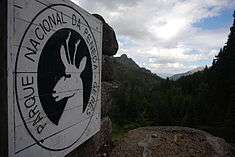
The 1971 classification of Peneda-Gerês as a national park came from a group of rules/requirements established to allow: the prudent use of the park's resources, preservation of existing flora and fauna species, allowing for the continued cohabitation, while providing an environment for scientific, educational and touristic investigation. These specified:
- Areas of Natural Environments (Portuguese: Áreas de Ambiente Natural), these were defined in 1991 into three zones:
- Integrated reserves, to preserve habitats and natural elements that were unique, vulnerable, rare, threatened or representative;
- Partial reserves, to allow conservation and environmental interpretation;
- Complementary areas, a transition zones between natural and rural environments.
- Freshwater Environments (Portuguese: Ambientes Dulçaquícolas), to provide means of management and conservation that would allow the constant preservation of existing water-based environments. The park is located within mountainous granite geomorphology, characterized by narrow watercourses, irregular inclines and unmineralized, highly oxygenated, semi-acidic, cold waters, which are the base of the ecosystem. Its importance, therefore, resulted in three-level classification of freshwater environments characterized by the natural resources that existed, and those activities which were permitted in each environment.
- Sites of Ornithological Interest (Portuguese: Sítios de Interesse Orintológico), areas identified for avian species conservation were prepared by Neves et al.
Human geography
Although there has been variable growth throughout the Norte region, there has been a general population decrease in those administrative units that fell within the Peneda-Gerês National Park (1981–1991), in the municipalities of Melgaço (-16.8%), Arcos de Valdevez (-13.4%), Ponte da Barca(-6.1%), Terras de Bouro (-7.2%), and Montalegre (-20.3%). There was a population of 9,099 according to the 1991 census, a 16% decrease from the 10,849 registered in 1981. There are no positive-negative variations between civil parishes; of those civil parishes that fell within the PNPG authority, their populations dropped from 0.8% (Vilar da Veiga) to 38.6% (Sezelhe).
These residents are concentrated primarily in various agglomerations: small nuclei separated from each other; an extension of buildings located along roadways; some isolated groups; constructions along agricultural roads in pasturelands; and three or more homes isolated by pastures.[16] Consequently, there are six homogeneous zones:
- Castro Laboreiro and Rio Laboreiro Valley - consisting of small agglomerations separated by short distances.[17] It was still common practice for the residents of mountain communities to spend part of the year in two locations, primarily near Castro Laboreiro. From about Easter to about Christmas, residents would live in homes above 1,000 m above sea level, known as branda (from the Portuguese brando, meaning mild or gentle). In the remaining part of the year, these inhabitants would occupy homes in the river valley, known as inverneira (from the Portuguese Inverno, meaning winter);
- Serras da Peneda and Serras do Soajo - small pastoral agglomerations, with different summer and winter residences;[17]
- Lima Valley and Serra Amarela - where the Lima Valley consists of two or more agglomerations connected by lines of residences between them, while in the Serra Amarela populations are concentrated in isolated pockets;
- Gerês Valley - development of tourism, around the Caniçada Dam and Thermal baths, resulted in uncontrolled re-construction, re-modelling and expansion of existing residences, although there already existed a tendency for expansion along the avenues and accessways along the valley;[17]
- Cabril-Gerês - steep areas along the River Cávado and Salamonde Dam, where buildings are concentrated along the accessways, and Cabril River, with pasturelands located between agglomerations;[17]
- Mourela/Barroso Plateau - extending south, southeast and southwest, the plateau is a series of agglomerations, connected by avenues of built-up occupation.[17] The expansion of Várzea, owing to the construction of the Paradela Dam, resulted in the reduction of cultivatable lands, meadows and marshes.[17]
Some of the villages in the high lands are located near the arable lands. Terraces, built to make better use of these scarce lands, and traditional houses, with granite walls and thatch roofs, shape the landscape with an indelible, harmonious, human mark in some of the most isolated villages such as Pitões das Júnias and Ermida.
Economy
The primary economic sector dominates the activities of residents that live within the park's territory. Although agricultural activity remains difficult, it still out-paces secondary and tertiary activities which, apart from the Terras de Bouro and Ponte da Barca, have been insignificant.[18] The inaccessibility and diminished exterior investment potential, has concentrated those activities in the region primarily in the exploration of forestry, the support of hydro-electrical generation and tourism.[18] But this too is limited; tourism is concentrated generally in the vicinity of Caldas do Gerês, hydro-electrical transmission has not affected the local economy, and along with forestry, has not seen an appreciable re-investment or re-capitalization of wealth (with income generated transferred outside the local market).[18]
The primary sector, although the largest contributor, is subsistence at best: supported by an ageing (mostly female) population; individual parcels are small and over-subdivided; producers that support familial or local clients; a production that is primarily concentrated on personal consumption; poor commercial networks; and physical and social isolation, with limited educational supports. Between 60-70% of the production is supported by subsidies.[18]
Industrial activities in the civil parishes within the park are poorly diversified and support familial businesses. Civil construction, although one of the larger economic supporters, has little effect on local incomes, since a majority of the employed come from outside the region.[19] Although there are a few larger operations (bread-making, construction and saw-milling/carpentry) most are small owner-operators, that support local consumption or occasional sales. Frequently, artisanal producers have disappeared, and have not been replaced by mass-produced or comparable vendors.[19]
Similarly, tertiary activities are limited small operators; commonly poorly diversified, dominated by commercial establishments and focused on local consumption, they are operated by families and do not generate much in employment.[19] Cafés and restaurants, are a good example of entrepreneurship, with many dotting the settlement landscape of the park's limits, primarily in the area of Gerês.[19] Other service sector activities are concentrated within the urbanized municipal seats and larger villages, with many of the more dynamic nuclei the centre of postal services, banks, posts for the G.N.R. or health centres.[19]
Tourism
The park tries to simultaneously encourage and control tourism, since the park's nature would not resist a massive flow of tourists. Accordingly there are six small camping sites and several hikingtrails are marked, making it relatively easy to find many of the most interesting spots, such as the castros at Castro Laboreiro and Calcedónia and the monastery at Pitões das Júnias. The trail at Mézio as a particular concern in describing some of the local features.
Locations near the few major roads are the most visited. Many of them are related to the strong religiousness of the people in northern Portugal namely the shrines at Senhora da Peneda and São Bento da Porta Aberta. Others, such as Soajo and Lindoso, display small, traditional granaries built of granite, the espigueiros (from the Portuguese espiga, meaning spike).
Probably the two most known and visited features are the many waterfalls, mostly the one near the old frontier station at Portela do Homem, and the Vilarinho das Furnas village, whenever the Vilarinho das Furnas Dam is low enough.
Two domestic animals also deserve being noted. The Barrosão ox, once used in agriculture, is nowadays endangered because it is losing its utility; as is also the Castro Laboreiro dog, a hunting dog.
References
Notes
- Vânia Andreia Malheiro Proença (2009), p.23
- Vânia Andreia Malheiro Proença (2009), p.24
- Vânia Andreia Malheiro Proença (2009), p.19-20
- J.B. Brilha et al. (1999), p.316
- Vânia Andreia Malheiro Proença (2009), p.20
- ICN (1995), p.6
- ICN (1995), p.7
- ICN (1995), p.8
- Vânia Andreia Malheiro Proença (2009), p.21
- Vânia Andreia Malheiro Proença (2009), p.22
- ICN (1995), p.23
- ICN (1995), p.24
- ICN (1995), p.25
- ICN (1995), p.26
- Mueller, Tom (July 2011), "The Delicate Balance of Portugal's Premier Park", National Geographic: 139
- ICN (1995), p.35-36
- ICN (1995), p.36
- ICN (1995), p.14
- ICN (1995), p.15
Sources
- Henriques, Pedro Castro (1990), Parques e reservas naturais de Portugal (in Portuguese), Lisbon, Portugal: Editorial Verbo, ISBN 972-22-1289-3
- Abreu, Maurício; Fernandes, José Manuel (1994), Serras de Portugal (in Portuguese), Círculo de Leitores, ISBN 972-42-0975-X
- Brilha, J.B.; Dias, G.; Mendes, A.; Henriques, R.; Azevedo, I.; Pereira, R. (1999), "The geological title of the Peneda-Gerês National Park (NW Portugal) and its electronic divulgation", in Barettino, D.; Vallejo, M.; Gallego, E. (eds.), Towards a balanced management and conservation of the geological heritage in the millennium (PDF), Salamanca, Spain: Sociedad Geológica de Espanã, pp. 315–318
- Plano de Ordenamento do Parque Natural da Peneda-Gerês (PDF) (in Portuguese), Braga, Portugal: Instituto da Conservação da Natureza, 1995, archived from the original (PDF) on 8 October 2011, retrieved 2 August 2011
- Proença, Vânia Andreia Malheiro (2009), Galicio-Portuguese oak forest of Quercus robur and Quercus pyrenaica: biodiversity patterns and forest response to fire (PDF), Lisbon, Portugal: Faculty of Sciences, University of Lisbon, p. 172